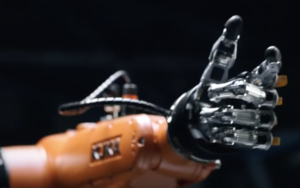One hand that replaces twelve – Sberbank starts using robot hands to count money
One of Russia’s biggest banks continues to replace human employees with robots, this time – using robot hands for counting money.

Artificial Intelligence (AI) solutions continue their journey into the human labour market, with the financial services sector strongly affected by this invasion. One of the best examples in terms of implementing robots that overtake the jobs of human staff has been Sberbank Rossii PAO (MCX:SBER). Early this year, the bank said it would replace 3,000 employees at its legal department with their jobs to be taken by a robot lawyer. The recently held Sberbank Annual Shareholder Meeting has brought another example of how the bank implements AI solutions to make its operations more efficient.
The bank showed a “Kuka Hand” – a robotic hand used to sort and count money. One such robot, according to Stanislav Kuznetsov, Deputy Chairman of the Executive Board of Sberbank, may replace six human beings. The solution will be gradually rolled out across Sberbank’s regional offices in 2017.
A number of Russian banks have tried to make the process of checking client accounts for AML compliance fully automated. However, this led to a flood of complaints in the end of February this year, as automated systems were massively blocking accounts.
Russian banks are not inclined to abandon the use of automated programs for compliance checks. The reason – if they do so, the expenses for staff and consultancy fees will rise significantly.
In Japan, the AI is also keeping up with its invasion in the financial services sector. According to a report by Japan’s Nikkei, Mizuho Bank and SoftBank plan to use AI for a new consumer loan service set to be introduced in September this year.
The AI solution will assess the right applicants for a loan. The program can process an application in 30 minutes, considering various indicators, such as a borrower’s bank and mobile phone bill records. The AI software will also take into account how frequently borrowers use ATMs, the borrowers’ hobbies and what the money will be spent on.









